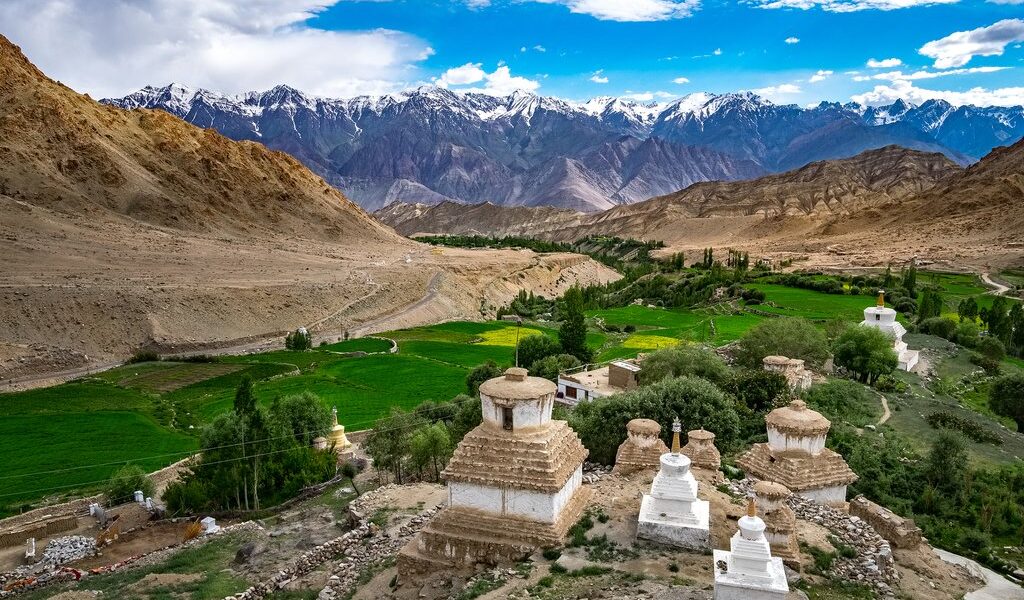The Slow Villages of Upper Sham and the Lessons They Pass Down to Travelers
By Declan P. O’Connor
Opening Reflection: A Valley Where Stillness Outlives the Road
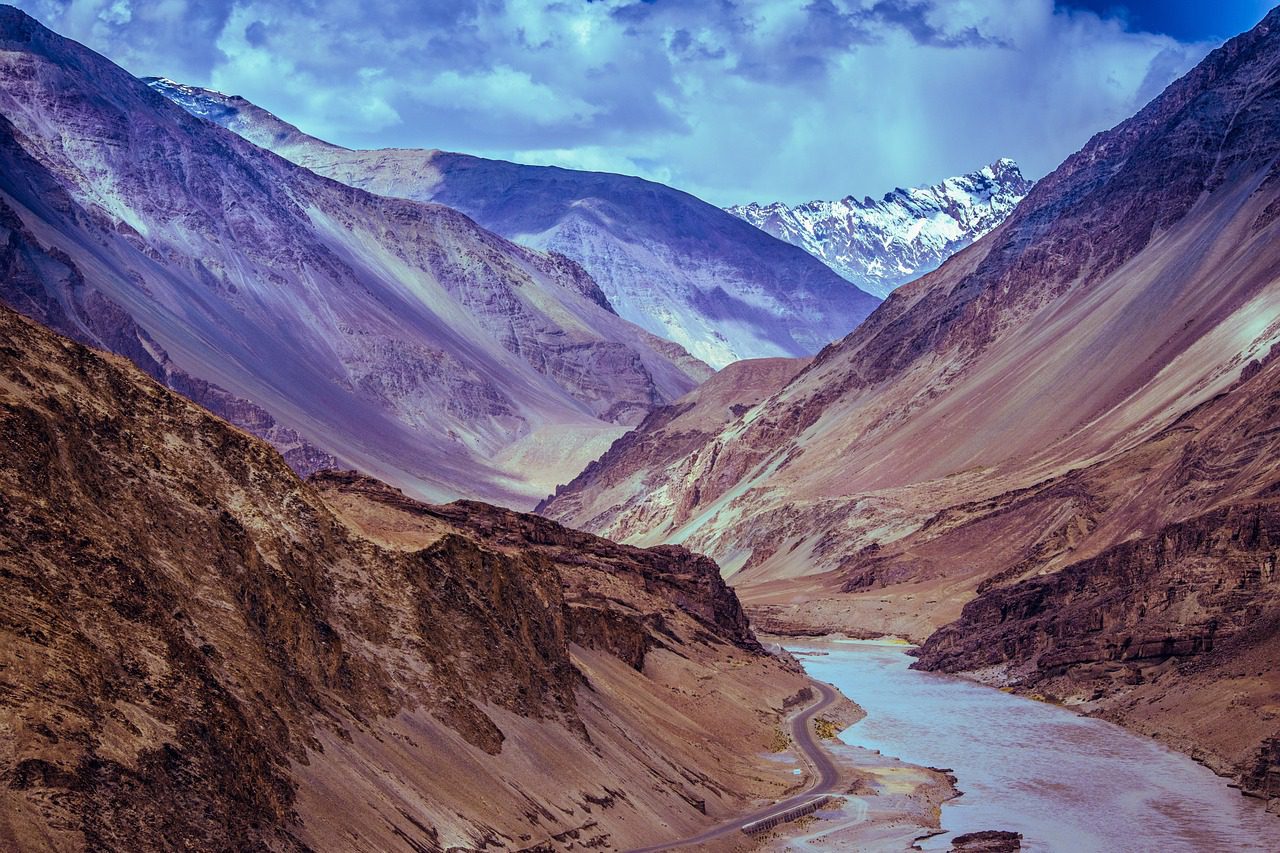
For most visitors, Ladakh is first a map and only later a memory. They sketch routes on a screen, trace the Indus with a fingertip, drop pins on monasteries whose names still feel abstract and distant. Yet the first time you drive west from Leh and the road begins to follow the river into Upper Sham, something quieter than the map begins to take over. The landscape does not rise to impress you all at once. It simply broadens and settles, as if the mountains have decided that their work is not to perform, but to endure.
Upper Sham is not a region of famous summits or dramatic passes. It is a chain of villages held together by fields, water channels, and the long patience of people who have learned how to live with thin air and long winters. For travelers used to hurried itineraries, the surprise is not that these villages are beautiful, but that they seem largely uninterested in our arrival. Life goes on at its own tempo, and the traveler can either slow down to meet it or watch it recede in the rear-view mirror.
In Upper Sham, it is the villages that set the pace of the journey, and the road merely negotiates the terms.
This is a quiet geography, mapped less by altitude and distance than by habits of attention. To understand Upper Sham, it is not enough to glance through the car window. You have to sit in the kitchen of a homestay, listen to the sound of tea boiling, notice how the afternoon light falls on the courtyard wall, and realize that the real journey is occurring somewhere inside your sense of time.
The Geography of Upper Sham: Light, Fields, and the Curve of the Indus
Upper Sham runs roughly along the Indus River as it bends westward from Leh, climbing gently through a landscape that looks, from a distance, almost monochrome. The mountains are dry and folded, painted in shades of beige, ash, and soft rust. Only when the road drops toward a village do the colors change. Suddenly there are green fields, whitewashed houses, apricot trees, and the deep, narrow line of an irrigation channel cutting across the slope like a deliberate signature.
Unlike the harsher high plateaus farther east, the villages of Upper Sham sit at altitudes that are serious but not punishing. The air is thin enough to slow a brisk European walker, yet kind enough to let most bodies adapt with a bit of care and patience. This combination makes Upper Sham one of the most forgiving gateways into rural Ladakh, a place where travelers can learn the rhythms of the high desert without being overwhelmed by it.
The villages themselves are arranged not according to the logic of tourism, but according to older needs: water, arable land, defensible positions, proximity to monasteries. The result is a chain of settlements that feel related yet distinct, like verses in a single long poem written along the river. As you move from one to the next, you begin to understand that this geography is not just physical. It is a web of paths, stories, and seasonal routines that has been quietly holding people here for centuries.
Village Profiles: The Places Where Light Stays Longer

Likir: Monastery Bells, Apricot Trees, and the First Lesson in Slowing Down
For many travelers, Likir is the first real pause after leaving Leh, a place where the journey shifts from transit to encounter. The village sits on a rise above the valley, its fields laid out like a careful offering below the walls of Likir Monastery. From a distance, the gompa dominates the view, its white and ochre buildings clinging to the hillside, the golden statue of the Buddha watching over the fields. Yet once you step out of the car and onto the footpaths between the houses, the monastery bells become only one voice among many.

Likir’s fields are a classroom in mountain agriculture. Barley, peas, and potatoes grow in narrow terraces cut into the slope, fed by small channels of meltwater guided by hand and by habit. In late summer, the apricot trees are heavy with fruit, and the courtyards are bright with orange slices laid out to dry. It is here that many European travelers first notice how differently time flows in a Ladakhi village. Tasks are not rushed, but they are rarely postponed. Work is done in a steady, communal rhythm, with a sense that the weather and the water, not the clock, are the final authorities.
Spend a night in Likir and you begin to feel your own speed recalibrate. The homestays are simple but generous, their kitchens warm with the smell of butter tea and fresh bread. Conversation moves gently between Ladakhi and broken English, punctuated by long, comfortable silences. Outside, the wind moves through the fields, and the monastery bells mark the hours with a kind of patient certainty. Likir does not ask you to stay. It simply demonstrates what staying looks like and leaves the decision to you.
Yangthang: Barley Fields, Whitewashed Rooms, and the Art of Being Hosted
If Likir is a first invitation to slow down, Yangthang is where that invitation becomes a lived experience. Reached by an undramatic but quietly beautiful walk over low ridges, the village sits in a basin of fields and orchards, its houses gathered like a small, bright constellation at the center. From the surrounding slopes, Yangthang appears almost self-contained, a compact world organized around water, soil, and the daily choreography of people and animals.
Yangthang is perhaps best known among trekkers for its homestays. To arrive here on foot, dusty from the trail and slightly breathless from the altitude, is to step directly into the heart of Ladakhi hospitality. Guests are ushered into whitewashed rooms lined with carpets and cushions, offered tea before questions, and given the sense that their presence is an addition to the household, not an interruption. There is a difference between service and hosting, and Yangthang quietly insists on the latter.
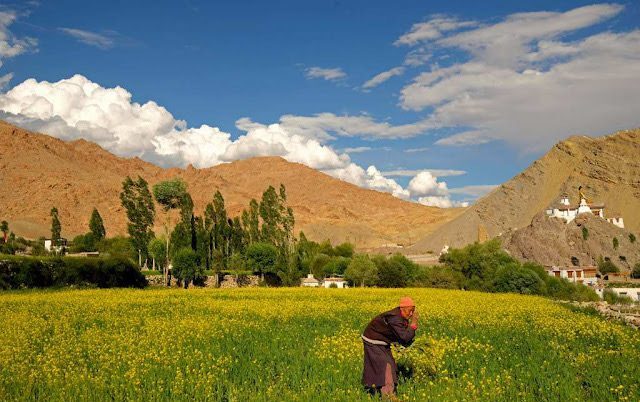
The barley fields around the village tell their own story. In early summer they are a soft, improbable green against the bare hills. By late season they have turned gold, their harvest a communal effort that draws in neighbors and relatives. For the traveler who lingers, these cycles become visible, and with them a deeper understanding of how a village holds itself together across generations. Yangthang does not rush to explain any of this. It assumes that if you are here, you have already chosen to walk at a pace that allows such details to register.
Hemis Shukpachan: Juniper Forests, Sacred Paths, and the Spiritual Heart of Upper Sham
Further along the trail, Hemis Shukpachan feels like a village that has grown around a series of quiet devotions. Its name comes from the abundance of juniper trees—shukpa—which are sacred in local tradition and used in rituals, offerings, and daily acts of purification. Walking into the village, you notice the shift almost at once. There is more shade, more fragrance, and a subtle sense that the landscape itself has been invited into the sphere of worship.
Prayer flags move in the breeze along ridgelines and footpaths, and small stupas stand where paths meet or where the view opens over the valley. Villagers pass them with a brief pause or a turn of the prayer wheel, gestures that take only a moment but carry centuries of habit and meaning. For the traveler, these small rituals can be disorienting at first. They do not demand participation, yet they quietly suggest that the space you are moving through is not purely secular.
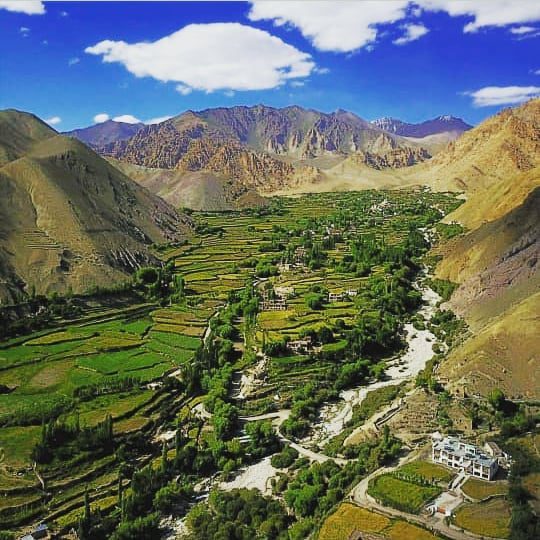
Hemis Shukpachan is often remembered by visitors as the most beautiful village of the trek, though this says as much about the inner state of the traveler as it does about the place. By the time most people reach it, they have spent days walking, sleeping in homestays, and adjusting to a slower rhythm of life. The village’s juniper groves and stone houses, its fields and shrines, are received by senses that have already been softened and opened by the journey. In that sense, Hemis Shukpachan is less a destination than a revelation: a moment when the quiet geography of Upper Sham finally comes into clear focus.
Uleytokpo: Indus River Light and the Night Sky as a Second Roof
Leaving the tight folds of the trekking routes, Uleytokpo brings you back down toward the river without quite returning you to the noise of the highway. The settlement stretches along the slope above the Indus, its camps and guesthouses arranged to catch both the afternoon sun and the open sky at night. For many travelers, Uleytokpo functions as a soft landing—an intermediate space between remote villages and the more familiar routines of road travel.
Here, the soundscape changes. The muffled quiet of high side valleys is replaced by the distant rush of the river and, occasionally, the low hum of a vehicle passing on the main road below. Yet Uleytokpo retains a gentleness that surprises first-time visitors. The accommodations are often simple eco-camps or small lodges, their gardens edged with poplars, their dining rooms filled with a mix of local families and foreign trekkers comparing notes on routes and passes.
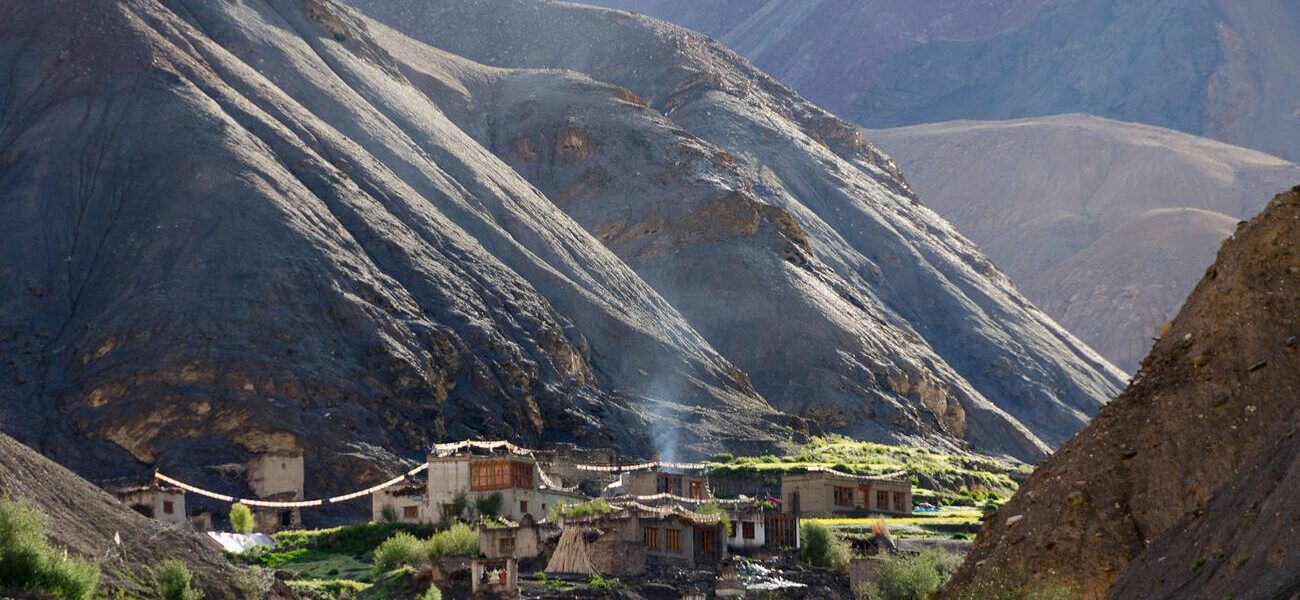
At night, when the generator noise fades and the conversations thin out, the sky takes over. In a region with little light pollution, Uleytokpo offers an unobstructed view of stars that seem close enough to touch. For European travelers used to city skies, this alone can feel like a reason to stay an extra night. In the morning, as the sun climbs over the ridge and the river brightens into motion, Uleytokpo reveals itself as what it has quietly been all along: a resting place that allows the body to recover and the mind to catch up with the journey.
Tar: A Hidden Hamlet at the End of a Narrow Gorge
Not all villages in Upper Sham announce themselves from the road. Tar must be earned. Reached by following a narrow gorge away from the main valley, this small settlement feels almost provisional at first glance, as if it were a secret that the mountains are only partly willing to share. The path in is lined with rock walls and the occasional trickle of water, the sky narrowed to a strip above your head. When the gorge opens and the village finally appears, the effect is quietly dramatic: houses, fields, and trees emerging suddenly from stone.
Tar is small even by Ladakhi standards. A handful of homes, a compact set of fields, a few animals grazing on any remaining patch of green. Yet the village carries a weight that is disproportionate to its size. Isolation has preserved not only certain architectural details and farming practices, but also a particular flavor of community life. People here know that the effort required to arrive acts as a filter. Those who come are either neighbors or travelers willing to walk further and longer than most.

For the visitor, Tar offers a concentrated version of what makes Upper Sham distinct. The hospitality is warm but unembellished, the food simple and sustaining. There is little in the way of distraction, which means that details stand out more sharply: the pattern of a woven rug, the way sunlight grazes a stone threshold, the sound of a child running across a courtyard. Time in Tar does not feel empty. It feels precisely measured, as if the village were reminding you that attention is the rarest and most valuable resource you have brought with you.
Temisgam: Orchard Light and the Memory of a Royal Past
Further west, Temisgam—often written as Tingmosgang—carries itself with a quiet assurance that hints at its former status. Once a royal seat, the village still bears the remains of an old palace and temples perched above the houses, their walls weathered but dignified. From the fields below, the ruins look less like relics and more like elders: still present, no longer in charge, but consulted in subtle ways.
The life of Temisgam today is anchored not in royal power but in agriculture and hospitality. Orchards of apricot and apple trees spread along the slope, their blossoms in spring and fruits in late summer marking the progress of the year. Homestays and small guesthouses welcome travelers who are often surprised by the combination of deep history and everyday normality. A day here might include walking up to the old palace, sitting in a quiet temple lit by butter lamps, and then descending to share dinner in a modern kitchen where children are doing homework under electric light.
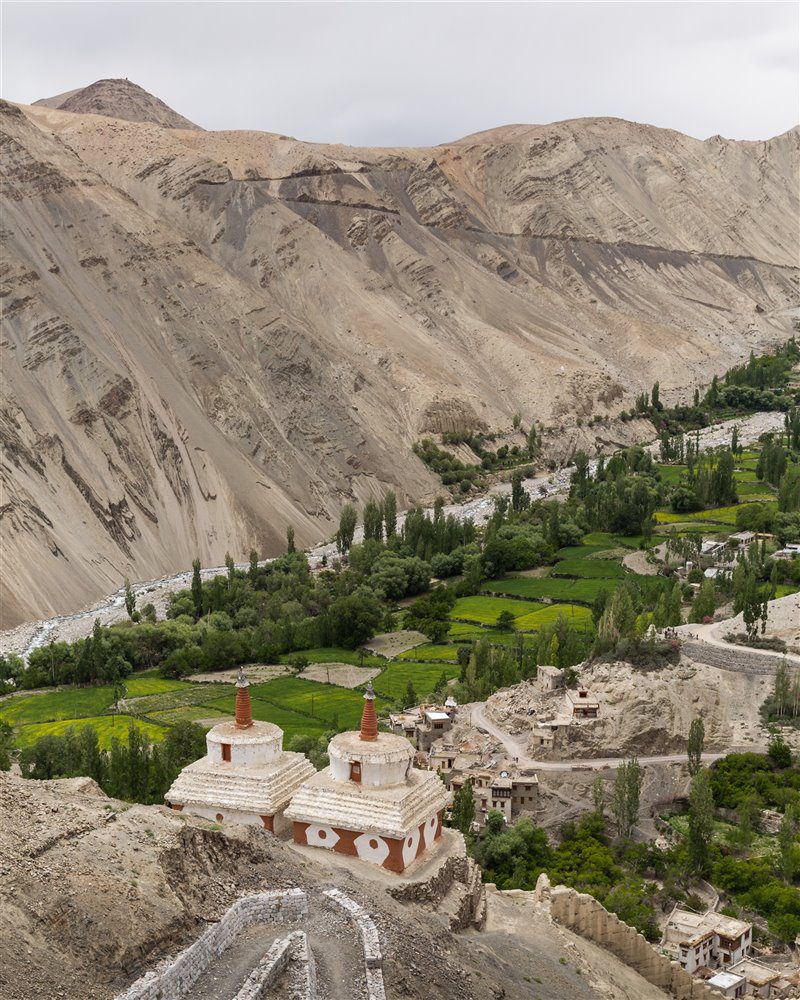
For European visitors, Temisgam offers a particularly clear view of how Ladakh holds its past and present together. The royal era is not romanticized, nor is it rejected. It is simply one layer among many in a village that has to think every year about water, crops, schooling, and the cost of sending a son or daughter to Leh for further studies. The lesson, if there is one, is that history is not something behind glass. It is something you live with, negotiate with, and occasionally climb up to visit when you need perspective.
Wanla: An Old Temple Watching Over a Quiet Valley
Wanla feels, at first approach, like a village slightly turned inward. The houses gather along the slope, the fields reach out toward the river, and above it all sits a temple complex that is older than most of the maps that now mark its location. The monastery here, associated with early Buddhist traditions in the region, is modest in size compared to some of Ladakh’s more famous gompas. Its significance lies less in spectacle than in continuity.
Climbing up to the temple, you pass through alleys and footpaths that double as social spaces. Neighbors exchange news at doorways, children weave between adults and animals, and the line between private and public life is more porous than in most European towns. Inside the temple, the air is thick with the smell of butter lamps and old wood. The paintings on the walls have survived centuries of wind, dust, and devotion. They are not pristine, but neither are they abandoned. Monks and villagers still come to chant, to repair, to clean, to remember.
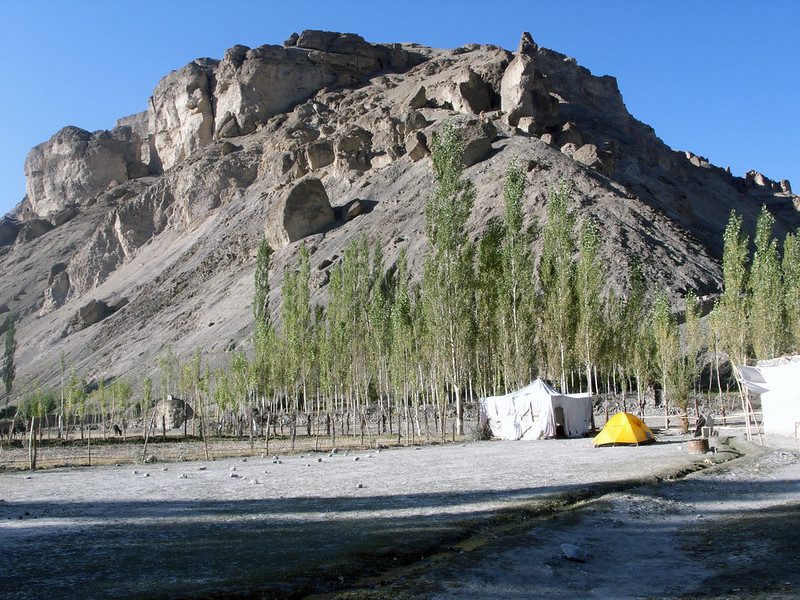
Wanla’s attraction for the traveler lies in this balance between age and use. The village does not feel like a museum, nor like a place rushing to modernize itself beyond recognition. It sits somewhere between, holding onto what matters and adapting where necessary. Walking back down from the temple at dusk, you can look across the valley and feel that the quiet here is not emptiness but density—a quiet built from layers of prayer, conversation, and shared labor. It is the kind of silence that leaves a mark.
Lamayuru: Moonland, Monastery, and the Threshold of Another World
By the time you reach Lamayuru, you are standing at what feels like the outer edge of Upper Sham and the threshold of something stranger. The village is famous for its “moonland” landscape—eroded cliffs and ridges carved into shapes that look almost lunar in certain light. Above this geological drama sits Lamayuru Monastery, a major spiritual center whose festivals and daily rituals draw both pilgrims and the mildly bewildered.
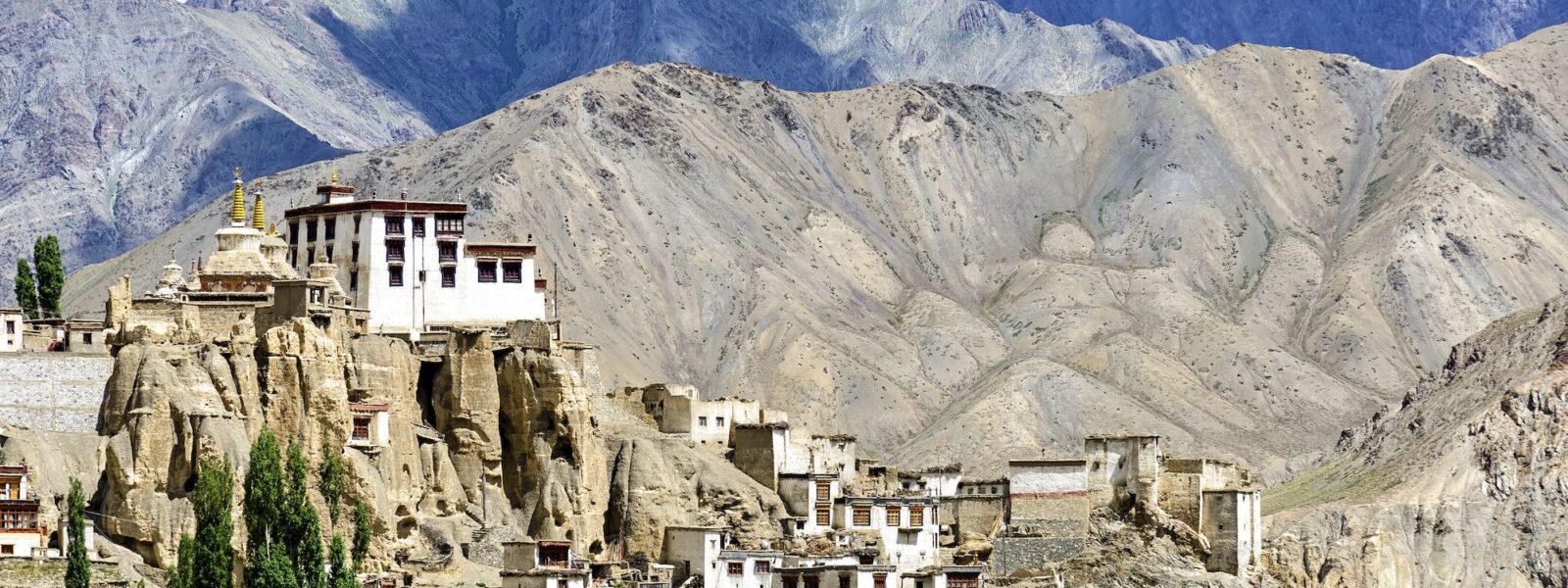
Lamayuru is larger and busier than the smaller villages upriver. There are more guesthouses, more restaurants, more obvious signs of the tourism economy. Yet it remains, at its core, a place structured around religious life and the practical needs of people who have chosen to live in a landscape that offers little for free. From the monastery courtyard, you can look out over the moonland formations and the scattered houses below and feel a perspective that is both physical and philosophical. The view suggests how small human projects are, and how astonishing it is that they exist at all.
For travelers, Lamayuru often serves as both a climax and a transition. It is the point where some turn back toward Leh, carrying with them impressions of Upper Sham’s villages, and others push onward toward the starker regions beyond. Either way, Lamayuru re-frames what has come before. The quiet barley fields of Yangthang, the juniper groves of Hemis Shukpachan, the hidden alleys of Wanla—all these memories are suddenly set against a horizon that feels more precarious and more vast. You leave with the sense that the villages you have passed through are not simply charming stops on a route, but deliberate acts of faith in the possibility of human settlement in such a place.
The Culture That Holds These Villages Together
Across Upper Sham, the specific details of each village differ, but the cultural threads that bind them are remarkably consistent. The agricultural year shapes not only the workday but also the calendar of festivals and family events. Sowing, irrigating, harvesting, and storing are tasks that require cooperation, and this need for shared labor has, over time, created a social fabric in which individual ambition is balanced by communal obligation. For visitors, this can be disorienting in small ways. Decisions about meals, transport, even pricing can sometimes feel slower or more negotiated than in a purely market-driven environment.
Religion, too, is woven into daily life without drawing a hard line between sacred and ordinary space. Monasteries oversee important rituals, but much of the spiritual practice is domestic: small altars in kitchens, mantras murmured during routine chores, prayer flags renewed when the wind has worn them thin. Hospitality grows out of this context. To offer tea, a bed, or directions is not merely a transaction. It is part of a wider understanding of how one lives correctly in a world where survival has always depended on mutual support. When European travelers find themselves repeatedly invited into homes, urged to eat more, or gently corrected when they walk clockwise instead of counterclockwise around a chorten, they are encountering this culture of care in action.
Closing Reflection: What Travelers Carry Home From Upper Sham
By the time you leave Upper Sham—whether you turn back toward Leh or continue west—the villages begin to reorder themselves in your memory. They no longer appear as separate stops on an itinerary, but as facets of a single, coherent world. Likir becomes inseparable from the first smell of barley fields in thin air. Yangthang is remembered as a particular kitchen, a particular laughter over dinner. Hemis Shukpachan holds the sensation of juniper smoke and the sound of distant chanting. Tar is the echo of footsteps in a gorge. Temisgam is the feeling of history that is still lived in, not just looked at. Wanla is a butter lamp in a dark, painted room. Lamayuru is the shock of moonland at dusk.
Travelers who come to Ladakh for dramatic landscapes often find, somewhat to their surprise, that what stays with them from Upper Sham are not the vast views but the small, precise details of village life: the way water glitters in a narrow channel, the careful stacking of fuel, the shared bowl of apricots set down without ceremony on a low table. These are not spectacular experiences in the usual sense. They are lessons in how to inhabit a demanding environment without becoming either hardened or hurried beyond recognition.
For European readers considering a journey here, the most honest invitation is not to “discover” untouched villages before someone else does. It is to enter a set of communities that have long been discovering, year after year, how to remain themselves while the world beyond the valley changes. Upper Sham will not rearrange itself to suit your schedule. It will, however, welcome you into its quiet geography—if you allow your own sense of time to loosen and your curiosity to deepen. What you carry home from such a journey is not just photographs or stories, but a slightly altered understanding of what it means to live at a human pace.

FAQ – Traveling Through the Villages of Upper Sham
Is Upper Sham suitable for first-time visitors to Ladakh?
Yes, Upper Sham is often ideal for first-time visitors because the altitudes are gentler than in other regions, the walking routes are moderate, and the villages provide homestays where you can adapt slowly to high-altitude life with plenty of local support and guidance.
How many days should I spend in the Upper Sham villages?
A minimum of three to four nights allows you to experience more than one village at an unhurried pace, but many travelers find that five to seven days give enough time for the body to acclimatize, the mind to slow down, and genuine relationships with hosts to begin forming naturally.
Do I need technical trekking experience to visit these villages?
No, most routes between the Upper Sham villages follow well-used paths with modest elevation gain, so a reasonably fit traveler accustomed to walking several hours a day can enjoy the journeys without specialized gear, provided they respect altitude, drink water, and listen to local advice.
Conclusion and Final Note
The villages of Upper Sham do not compete for your attention; they invite it. Each settlement, from Likir’s monastery fields to the moonlit ridges above Lamayuru, offers a different angle on the same enduring question: how does a community remain rooted in a place that is both fragile and demanding? To walk these paths and sleep in these homes is to glimpse one set of answers. They are not offered as universal solutions, but as lived examples of resilience, patience, and mutual care. If you leave with a slightly altered sense of time and a renewed respect for small, steady work, then Upper Sham has already shared more than enough of its light.
About the Author
Declan P. O’Connor is the narrative voice behind Life on the Planet Ladakh,
a storytelling collective exploring the silence, culture, and resilience of Himalayan life.

